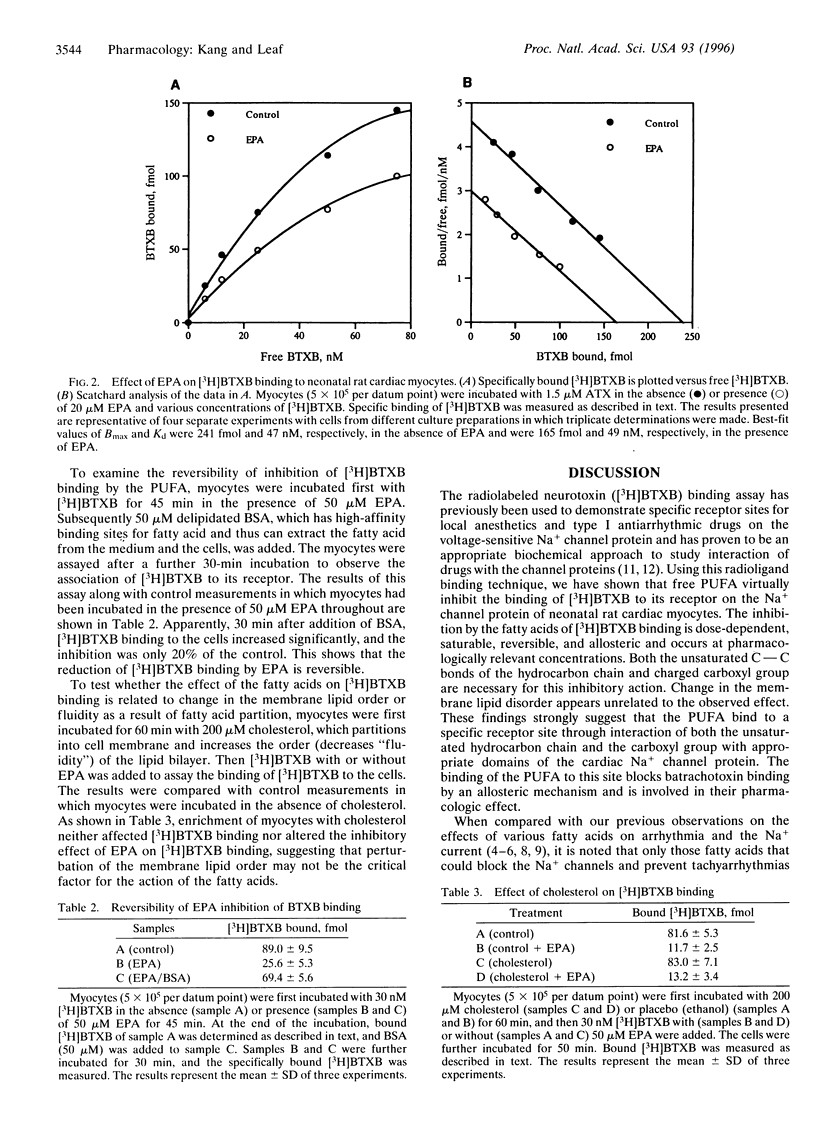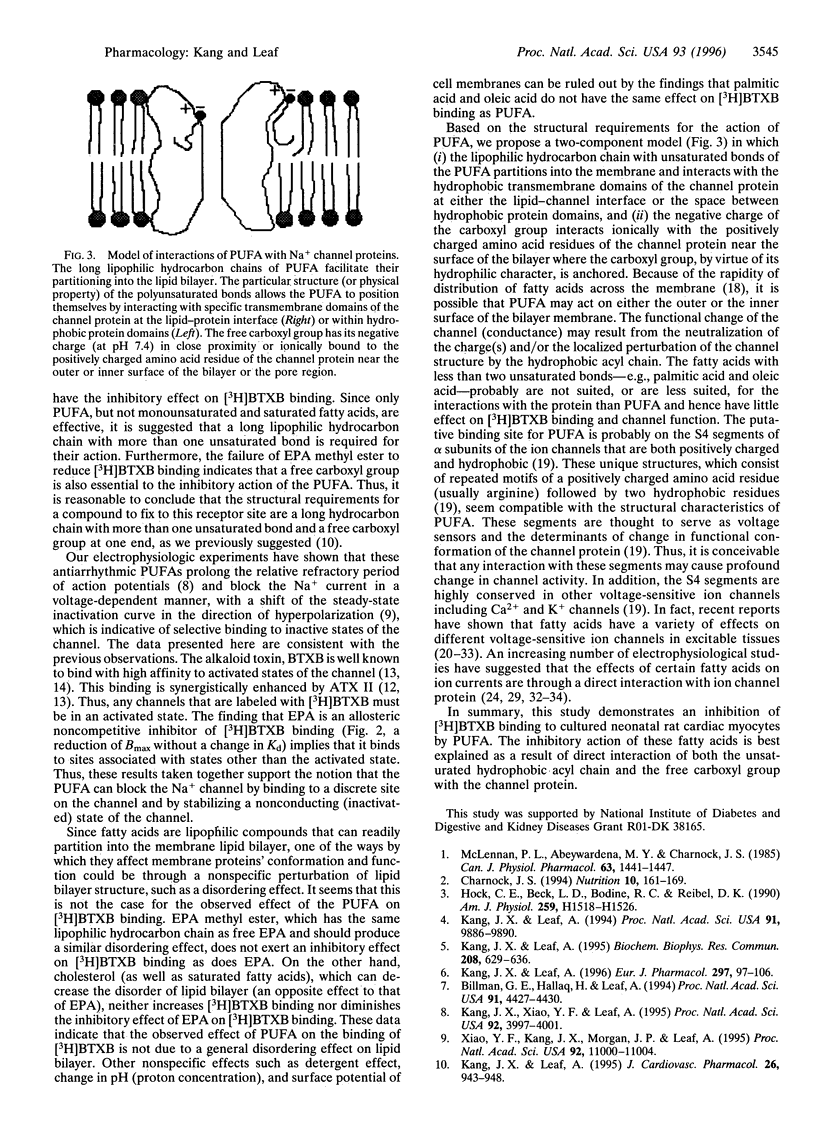Abstract
The effects of free polyunsaturated fatty acids (PUFA) on the binding of ligands to receptors on voltage-sensitive Na+ channels of neonatal rat cardiac myocytes were assessed. The radioligand was [benzoyl-2,5-(3)H] batrachotoxinin A 20alpha-benzoate ([(3)H]BTXB), a toxin that binds to the Na+ channel. The PUFA that have been shown to be antiarrhythmic, including eicosapentaenoic acid (EPA; C20:5n-3), docosahexaenoic acid (DHA; C22:6n-3), eicosatetraynoic acid (ETYA), linolenic acid (C18:3n-3), and linoleic acid (C18:2n-6), inhibited [(3)H]BTXB binding in a dose-dependent fashion with IC50 values of 28-35 microM, whereas those fatty acids that have no antiarrhythmic effects including saturated fatty acid (stearic acid, C18:0), monounsaturated fatty acid (oleic acid; C18:1n-9), and EPA methyl ester did not have a significant effect on [(3)H]BTXB binding. Enrichment of the myocyte membrane with cholesterol neither affected [(3)H]BTXB binding when compared with control cells nor altered the inhibitory effects of PUFA on [(3)H]BTXB binding. Scatchard analysis of [(3)H]BTXB binding showed that EPA reduced the maximal binding without altering the Kd for [(3)H]BTXB binding, indicating allosteric inhibition. The inhibition by EPA of [(3)H]BTXB binding was reversible (within 30 min) when delipidated bovine serum albumin was added. The binding of the PUFA to this site on the Na+ channel is reversible and structure-specific and occurs at concentrations close to those required for apparent antiarrhythmic effects and a blocking effect on the Na+ current, suggesting that binding of the PUFA at this site relates to their antiarrhythmic action.
Full text
PDF




Selected References
These references are in PubMed. This may not be the complete list of references from this article.
- Billman G. E., Hallaq H., Leaf A. Prevention of ischemia-induced ventricular fibrillation by omega 3 fatty acids. Proc Natl Acad Sci U S A. 1994 May 10;91(10):4427–4430. doi: 10.1073/pnas.91.10.4427. [DOI] [PMC free article] [PubMed] [Google Scholar]
- Burt J. M. Uncoupling of cardiac cells by doxyl stearic acids specificity and mechanism of action. Am J Physiol. 1989 Apr;256(4 Pt 1):C913–C924. doi: 10.1152/ajpcell.1989.256.4.C913. [DOI] [PubMed] [Google Scholar]
- Catterall W. A., Beress L. Sea anemone toxin and scorpion toxin share a common receptor site associated with the action potential sodium ionophore. J Biol Chem. 1978 Oct 25;253(20):7393–7396. [PubMed] [Google Scholar]
- Catterall W. A. Neurotoxins that act on voltage-sensitive sodium channels in excitable membranes. Annu Rev Pharmacol Toxicol. 1980;20:15–43. doi: 10.1146/annurev.pa.20.040180.000311. [DOI] [PubMed] [Google Scholar]
- Catterall W. A. Structure and function of voltage-sensitive ion channels. Science. 1988 Oct 7;242(4875):50–61. doi: 10.1126/science.2459775. [DOI] [PubMed] [Google Scholar]
- Charnock J. S. Dietary fats and cardiac arrhythmia in primates. Nutrition. 1994 Mar-Apr;10(2):161–169. [PubMed] [Google Scholar]
- Hock C. E., Beck L. D., Bodine R. C., Reibel D. K. Influence of dietary n-3 fatty acids on myocardial ischemia and reperfusion. Am J Physiol. 1990 Nov;259(5 Pt 2):H1518–H1526. doi: 10.1152/ajpheart.1990.259.5.H1518. [DOI] [PubMed] [Google Scholar]
- Honoré E., Barhanin J., Attali B., Lesage F., Lazdunski M. External blockade of the major cardiac delayed-rectifier K+ channel (Kv1.5) by polyunsaturated fatty acids. Proc Natl Acad Sci U S A. 1994 Mar 1;91(5):1937–1941. doi: 10.1073/pnas.91.5.1937. [DOI] [PMC free article] [PubMed] [Google Scholar]
- Huang J. M., Xian H., Bacaner M. Long-chain fatty acids activate calcium channels in ventricular myocytes. Proc Natl Acad Sci U S A. 1992 Jul 15;89(14):6452–6456. doi: 10.1073/pnas.89.14.6452. [DOI] [PMC free article] [PubMed] [Google Scholar]
- Kamp F., Hamilton J. A., Kamp F., Westerhoff H. V., Hamilton J. A. Movement of fatty acids, fatty acid analogues, and bile acids across phospholipid bilayers. Biochemistry. 1993 Oct 19;32(41):11074–11086. doi: 10.1021/bi00092a017. [DOI] [PubMed] [Google Scholar]
- Kang J. X., Leaf A. Effects of long-chain polyunsaturated fatty acids on the contraction of neonatal rat cardiac myocytes. Proc Natl Acad Sci U S A. 1994 Oct 11;91(21):9886–9890. doi: 10.1073/pnas.91.21.9886. [DOI] [PMC free article] [PubMed] [Google Scholar]
- Kang J. X., Leaf A. Prevention and termination of beta-adrenergic agonist-induced arrhythmias by free polyunsaturated fatty acids in neonatal rat cardiac myocytes. Biochem Biophys Res Commun. 1995 Mar 17;208(2):629–636. doi: 10.1006/bbrc.1995.1385. [DOI] [PubMed] [Google Scholar]
- Kang J. X., Leaf A. Protective effects of All-trans-retinoic acid against cardiac arrhythmias induced by isoproterenol, lysophosphatidylcholine or ischemia and reperfusion. J Cardiovasc Pharmacol. 1995 Dec;26(6):943–948. doi: 10.1097/00005344-199512000-00014. [DOI] [PubMed] [Google Scholar]
- Kang J. X., Leaf A. Protective effects of free polyunsaturated fatty acids on arrhythmias induced by lysophosphatidylcholine or palmitoylcarnitine in neonatal rat cardiac myocytes. Eur J Pharmacol. 1996 Feb 15;297(1-2):97–106. doi: 10.1016/0014-2999(95)00701-6. [DOI] [PubMed] [Google Scholar]
- Kang J. X., Xiao Y. F., Leaf A. Free, long-chain, polyunsaturated fatty acids reduce membrane electrical excitability in neonatal rat cardiac myocytes. Proc Natl Acad Sci U S A. 1995 Apr 25;92(9):3997–4001. doi: 10.1073/pnas.92.9.3997. [DOI] [PMC free article] [PubMed] [Google Scholar]
- Kim D., Clapham D. E. Potassium channels in cardiac cells activated by arachidonic acid and phospholipids. Science. 1989 Jun 9;244(4909):1174–1176. doi: 10.1126/science.2727703. [DOI] [PubMed] [Google Scholar]
- Kim D., Duff R. A. Regulation of K+ channels in cardiac myocytes by free fatty acids. Circ Res. 1990 Oct;67(4):1040–1046. doi: 10.1161/01.res.67.4.1040. [DOI] [PubMed] [Google Scholar]
- Kirber M. T., Ordway R. W., Clapp L. H., Walsh J. V., Jr, Singer J. J. Both membrane stretch and fatty acids directly activate large conductance Ca(2+)-activated K+ channels in vascular smooth muscle cells. FEBS Lett. 1992 Feb 3;297(1-2):24–28. doi: 10.1016/0014-5793(92)80319-c. [DOI] [PubMed] [Google Scholar]
- Linden D. J., Routtenberg A. cis-Fatty acids, which activate protein kinase C, attenuate Na+ and Ca2+ currents in mouse neuroblastoma cells. J Physiol. 1989 Dec;419:95–119. doi: 10.1113/jphysiol.1989.sp017863. [DOI] [PMC free article] [PubMed] [Google Scholar]
- Miller B., Sarantis M., Traynelis S. F., Attwell D. Potentiation of NMDA receptor currents by arachidonic acid. Nature. 1992 Feb 20;355(6362):722–725. doi: 10.1038/355722a0. [DOI] [PubMed] [Google Scholar]
- Ordway R. W., Walsh J. V., Jr, Singer J. J. Arachidonic acid and other fatty acids directly activate potassium channels in smooth muscle cells. Science. 1989 Jun 9;244(4909):1176–1179. doi: 10.1126/science.2471269. [DOI] [PubMed] [Google Scholar]
- Pepe S., Bogdanov K., Hallaq H., Spurgeon H., Leaf A., Lakatta E. Omega 3 polyunsaturated fatty acid modulates dihydropyridine effects on L-type Ca2+ channels, cytosolic Ca2+, and contraction in adult rat cardiac myocytes. Proc Natl Acad Sci U S A. 1994 Sep 13;91(19):8832–8836. doi: 10.1073/pnas.91.19.8832. [DOI] [PMC free article] [PubMed] [Google Scholar]
- Petrou S., Ordway R. W., Singer J. J., Walsh J. V., Jr A putative fatty acid-binding domain of the NMDA receptor. Trends Biochem Sci. 1993 Feb;18(2):41–42. doi: 10.1016/0968-0004(93)90050-w. [DOI] [PubMed] [Google Scholar]
- Postma S. W., Catterall W. A. Inhibition of binding of [3H]batrachotoxinin A 20-alpha-benzoate to sodium channels by local anesthetics. Mol Pharmacol. 1984 Mar;25(2):219–227. [PubMed] [Google Scholar]
- Rouzaire-Dubois B., Gérard V., Dubois J. M. Modification of K+ channel properties induced by fatty acids in neuroblastoma cells. Pflugers Arch. 1991 Nov;419(5):467–471. doi: 10.1007/BF00370790. [DOI] [PubMed] [Google Scholar]
- Schmitt H., Meves H. Modulation of neuronal calcium channels by arachidonic acid and related substances. J Membr Biol. 1995 Jun;145(3):233–244. doi: 10.1007/BF00232715. [DOI] [PubMed] [Google Scholar]
- Sheldon R. S., Cannon N. J., Duff H. J. A receptor for type I antiarrhythmic drugs associated with rat cardiac sodium channels. Circ Res. 1987 Oct;61(4):492–497. doi: 10.1161/01.res.61.4.492. [DOI] [PubMed] [Google Scholar]
- Takenaka T., Horie H., Hori H., Kawakami T. Effects of arachidonic acid and the other long-chain fatty acids on the membrane currents in the squid giant axon. J Membr Biol. 1988 Dec;106(2):141–147. doi: 10.1007/BF01871396. [DOI] [PubMed] [Google Scholar]
- Toraason M., Luken M. E., Breitenstein M., Krueger J. A., Biagini R. E. Comparative toxicity of allylamine and acrolein in cultured myocytes and fibroblasts from neonatal rat heart. Toxicology. 1989 May 31;56(1):107–117. doi: 10.1016/0300-483x(89)90216-3. [DOI] [PubMed] [Google Scholar]
- Wieland S. J., Fletcher J. E., Gong Q. H., Rosenberg H. Effects of lipid-soluble agents on sodium channel function in normal and MH-susceptible skeletal muscle cultures. Adv Exp Med Biol. 1991;301:9–19. doi: 10.1007/978-1-4684-5979-1_2. [DOI] [PubMed] [Google Scholar]
- Xiao Y. F., Kang J. X., Morgan J. P., Leaf A. Blocking effects of polyunsaturated fatty acids on Na+ channels of neonatal rat ventricular myocytes. Proc Natl Acad Sci U S A. 1995 Nov 21;92(24):11000–11004. doi: 10.1073/pnas.92.24.11000. [DOI] [PMC free article] [PubMed] [Google Scholar]


